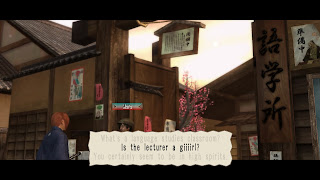Finally, Subculture has come back to the WWE! THQ and Yukes were best known for
their involvement with the popular wrestling franchise Smackdown! Previous installments of
the series delivered copious amounts of entertainment, but Here Comes The Pain take it up a notch in terms of gameplay, variance
and customization. The game boasts up to 50 playable wrestlers including current male wrestlers, divas and legends from the 80s-90s eras, each with his or her own
unique moveset and personality. Every match feels like a unique experience because of this, but it is only a small claim next to THQ's greatest creation ever released for the PlayStation 2.
 |
| Playing It For The Plot |
 Here Comes the Pain features a plethora of player customization. The Create-A-Wrestler mode is a deep and user-friendly. Players can customize his or her own wrestler from
the bottom up. Ranging from tattoos to mask, the mode lets you customize almost
every part of the wrestler, including clothing and attributes. Players may also choose pre-designed posters and signs the audience may hold
up during matches. Further exploring customization, Here Comes the Pain includes Create-A-Move-set and Create-A-Taunt feature. The latter mode allows players to further craft their wrestler's personalities, finishers and taunts. Creating a taunt is a great concept, but it's clunky. Although, making a unique
celebration by flipping everyone off while doing a back-flip may be the
best thing you can ever make in the game. Lastly, players can make their own entrances, choosing what song and video will play from the titantron.
Here Comes the Pain features a plethora of player customization. The Create-A-Wrestler mode is a deep and user-friendly. Players can customize his or her own wrestler from
the bottom up. Ranging from tattoos to mask, the mode lets you customize almost
every part of the wrestler, including clothing and attributes. Players may also choose pre-designed posters and signs the audience may hold
up during matches. Further exploring customization, Here Comes the Pain includes Create-A-Move-set and Create-A-Taunt feature. The latter mode allows players to further craft their wrestler's personalities, finishers and taunts. Creating a taunt is a great concept, but it's clunky. Although, making a unique
celebration by flipping everyone off while doing a back-flip may be the
best thing you can ever make in the game. Lastly, players can make their own entrances, choosing what song and video will play from the titantron. |
| The friendliest wrestler ever, Chris Jericho. |
 |
| Oh! The Blood! |
Opposite the positives in this game, Here Comes The Pain's negatives are minuscule. Some wrestlers were removed, such as the legendary Hulk Hogan, Jeff Hardy and Ultimate Warrior. And a few of the wrestler's entrance theme songs were missing. Because of licensing dilemmas, some wrestlers have instrumental renditions of their theme songs that come off as a little too cheesy sometimes. Color commentators are absent from the game as well, so don't expect any play by play announcements. Expect to only be bombarded with nothing but the same soundtrack playing over and over again for every match. Nevertheless, these are only minor complains juxtaposed to the entire game.
Overall, the game's intuitive controls make it fun and, at the same time, easy for newcomers to jump right into the action. The creative repertoire of Here Comes the Pain allows players to vividly design their wrestlers from the bottom up and turn them into legends within the story mode. Boasting tons of gameplay and an aesthetically pleasing look, Here Comes The Pain may as well take the crown for being the best wrestling game to be ever released for the PlayStation 2.


































